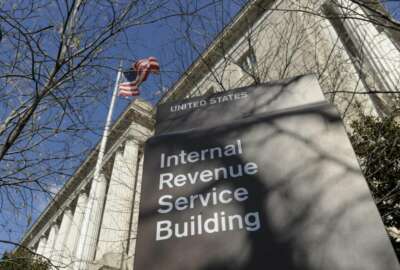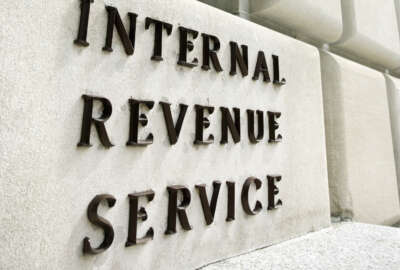

The agency stood up its Enterprise Digitalization and Case Management Office in July to digitize paper-based taxpayer services and consolidate its case-manageme...
Best listening experience is on Chrome, Firefox or Safari. Subscribe to Federal Drive’s daily audio interviews on Apple Podcasts or PodcastOne.
The IRS is building up a successful concept within its procurement shop — incrementally funding IT modernization projects and pulling the plug on those that don’t yield results — to digitize taxpayer services that still rely on paper-based processes.
The agency stood up its Enterprise Digitalization and Case Management Office in July to digitize paper-based taxpayer services and consolidate its case-management systems.
Former Deputy Chief Procurement Officer Harrison Smith and former Director of Enterprise Case Management Justin Lewis Abold-LaBreche now serve as co-directors of the office, which will lead the agency’s migration of business processes from legacy systems and onto a cloud-based enterprise case management system developed by Pegasystems.
Abold-LaBreche said the first phase of this migration has been in development for the past 12-15 months, but by December, the office will have its first business process live on its new platform, which will improve taxpayer services both for the public and for IRS employees.
“We have a fast feedback loop all the way to the end-user employee to say, ‘Is this working for you?’ and they’re involved in the development cycle. And then the big picture, we’re tackling business process modernization policy change and technology all at the same time, and we’re doing that in these bite-sized chunks, so it makes big change possible, but in a less risky way,” he said in an interview.
The IRS has more than 60 legacy systems that, for the most part, can’t communicate with each other, giving employees an incomplete picture of the steps a taxpayer has already taken before calling the agency with questions. In addition, the agency still handles many processes through mailed-in paperwork.
“Digitalization is not just about taking paper and turning it into an electronic format. It really is empowering the taxpayer and our employees to resolve issues in a digital channel, and we got to a place where it became obvious that we needed to really bring in additional leadership attention and resources to be able to grab hold of this big opportunity,” Abold-LaBreche said.
While the IRS has acknowledged the challenges of its legacy IT systems, Congress last summer passed the Taxpayer First Act, which requires the agency to develop a strategy to overhaul its taxpayer services before the end of the fiscal year.
The independent National Taxpayer Advocate has urged the IRS for years to move to a modern IT platform with systems that can “talk to each other” and give call-center employees a complete picture of a taxpayer’s questions or concerns when they call the agency.
In modernizing these systems and processes, Abold-LaBreche said taxpayers will be able to complete more tasks online and get more feedback from the agency, while employees will no longer have to navigate multiple systems to assist taxpayers.
The enterprise case management system, he added, would ultimately allow IRS employees to help taxpayers get the service they need in fewer calls.
“Sometimes it can be quite challenging, because they’re not able to see all of the aspects of a taxpayer’s interaction with us,” Abold-LaBreche said. “This makes it hard for them to resolve as many issues as they would like to with taxpayers on the phone. By bringing these different case management processes onto a shared platform, we’re going to make it possible for that customer service representative to have that wider view, that 360-degree view.”
The EDCMO’s approach to modernization also borrows from Pilot IRS, a procurement office program that provided incremental funding to IT pilots that showed the most promise for scaling up into broader agency adoption.
By building out a portfolio of projects and taking on this work in “smaller chunks,” Smith said the IRS can identify viable ideas in weeks and months, instead of quarters and years.
“Identifying opportunities where we can take an informed shot and frankly an informed risk and continue if something works before we really invest a significant amount of money, it’s really a very strong business case for how we’re pursuing things in this office in general,” Smith said.
A solution’s long-term viability often comes down to whether or not it fits into the agency’s existing IT architecture, meets employees’ needs and streamlines the overall business process.
“We can take this more agile approach, if you will, looking at minimum viable products and the like,” Smith said. “We want to make sure that we can kick the tires as much as possible before committing to things so that we don’t get overburdened. At the same time, you don’t want to go run around chasing shiny objects.”
Pilot IRS remains ongoing, and earlier this week posted a draft request for proposals for a “data mashing” initiative, aimed at giving the agency’s procurement office better visibility into disparate sets of labor and wage data.
Meanwhile, the IRS remains in the early stages of a six-year IT modernization strategy focused on four pillars: taxpayer experience, enforcement, operations and cybersecurity.
By the end, the agency looks to modernize its Individual Master File, the engine behind the hundreds of millions of income tax returns filed every year.
Copyright © 2024 Federal News Network. All rights reserved. This website is not intended for users located within the European Economic Area.
Jory Heckman is a reporter at Federal News Network covering U.S. Postal Service, IRS, big data and technology issues.
Follow @jheckmanWFED



